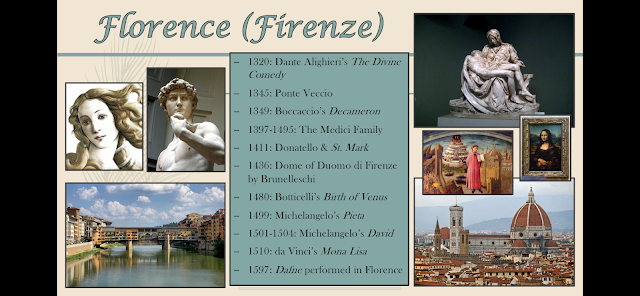Renaissance Italy
------------------------------------------------------------------------------
The focus of this lesson is Florence (Firenze).
Crash Course European History: Florence and the Renaissance
------------------------------------------------------------------------------
- Boccaccio's The Decameron:
- A collection of stories about a group of young Florentine people who are trying to escape the Black Plague by hiding out in the a nearby, secluded villa.
- Written in the Florentine vernacular
- masterpiece of early Italian prose
- The Medici:
- A prominent family of Florence whose influence resounds throughout the Renaissance
- banking and political dynasty
- Cosimo Medici most well known
- Four Popes: Leo X (refused the divorce of Henry VIII and Catherine of Aragon), Clement VII (Henry VIII breaks from the Catholic Church to form the Church of England), Pius IV, and Leo XI
- Patrons of the arts: Leonardo da Vinci, Michelangelo, Machiavelli, Galileo, etc.
- Like the Borgia of Rome
- bankrolled the invention of the piano and the opera
- Donatello and St. Mark: first free standing statue
----------------------------------------------------------------------
Brunelleschi's Dome
-----------------------------------------------------------------------------------------
- Petrarchism:
- Written in the style of Petrarch
- literary style found in most sonnets, canzone, madrigals, and sestine
- Spread to other literary traditions in Spain, France, and England
- Shakespeare's sonnets
- Classical Latin verse plus vernacular
- metaphorical descriptions----> "shining eyes" or "fire and ice" or "radiant smile"; paradoxes and oxymorons
- poems that are narrative, emotional, or ritual
------------------------------------------------------------------
The Divine Comedy- Bishop Robert Barron
For reading The Divine Comedy, I would suggest the following translation. It has fabulous notes and sketches to help the ready envision the scope of the tales.












































